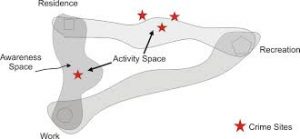Is crime related to geography?
This week lectures involved the geography of crime. We began by reviewing several theories in criminology. For example, the Crime Pattern Theory, which entails four basic assumptions:
-
- Crimes are complex – and need various specific elements to occur
- Crime is not random – due to non-uniform distribution of spatial and temporal criminals and victims
- Criminals and victims navigate through urban settings like any “normal” people – and thus also have “normal” routine patterns
- and finally that over time, criminals will develop a consistent region within which they commit crimes based on their routine patterns

We also discussed Routine Activity Theory, Rational Choice Theory, Broken Windows Theory, and more. It may be noted that a lot of these theories are based on many assumptions, and thus can only be viewed as general trends but not necessarily applicable in all circumstances.
The many applications of GIS in crime analysis are particularly interesting to me, since this topic has intriguing ties to psychology and the social sciences. Understanding why and how people move across space and interact with their surroundings can indicate where crimes are more likely to occur, and thus help law enforcement create effective strategies to reduce crime in urban settings.